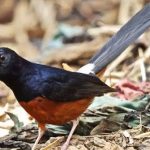Blyth's kingfisher
 |
| (Photo from World Birds) |
Common name:
Blyth’s kingfisher (en); guarda-rios-de-Blyth (pt); martin-pêcheur de Blyth (fr); martín pescador hércules (es); Herkules eisvogel (de)
Taxonomy:
Order Coraciiformes
Family Alcedinidae
Range:
This species is found from extreme north-eastern India and eastern Nepal, into extreme southern China, and southwards into Myanmar, northern Thailand, Laos and Vietnam.
Size:
These birds are 22 cm long and weigh around 60 g.
Habitat:
The Blyth’s kingfisher is found along streams and small rivers, and adjacent areas of moist tropical forests, favouring deep ravines and hilly country. They occur at altitudes of 200-1.200 m.
Diet:
They feed mainly on fish, but are also known to take some insects.
Breeding:
Blyth’s kingfishers breed in March-July. They nest is placed at the end of a deep tunnel, excavated into the bank of forest stream or vertical face of forest ravine. There the female lays 4-6 eggs which are incubated by both parents. There is no available information regarding the length of the incubation and fledging periods.
Conservation:
IUCN status – NT (Near-Threatened)
This species has a large breeding range and is reported to be widespread, but occurring at low densities. The population is suspected to be declining at a slow to moderate rate, mainly due to habitat loss and fragmentation caused by ongoing deforestation. Construction of dams, human disturbance and river pollution possibly also affect this species.































